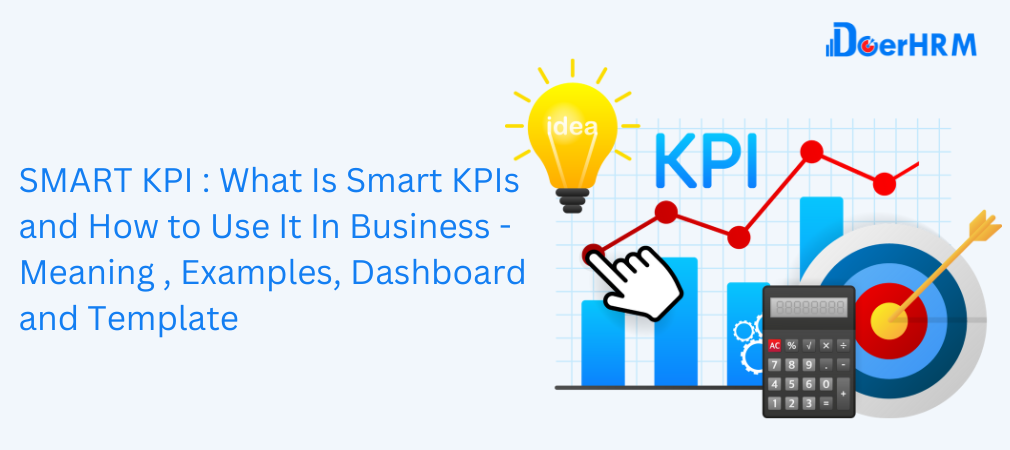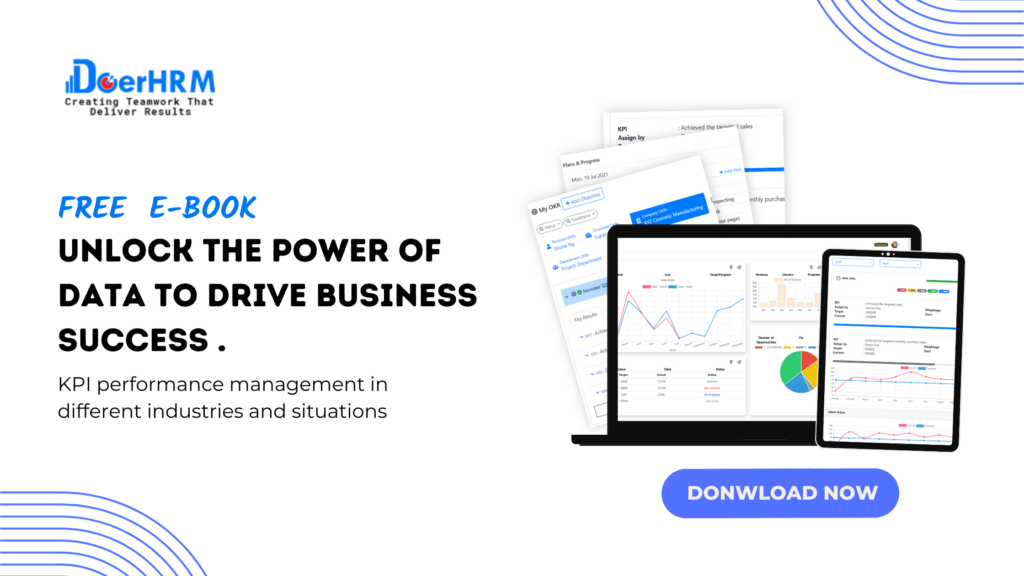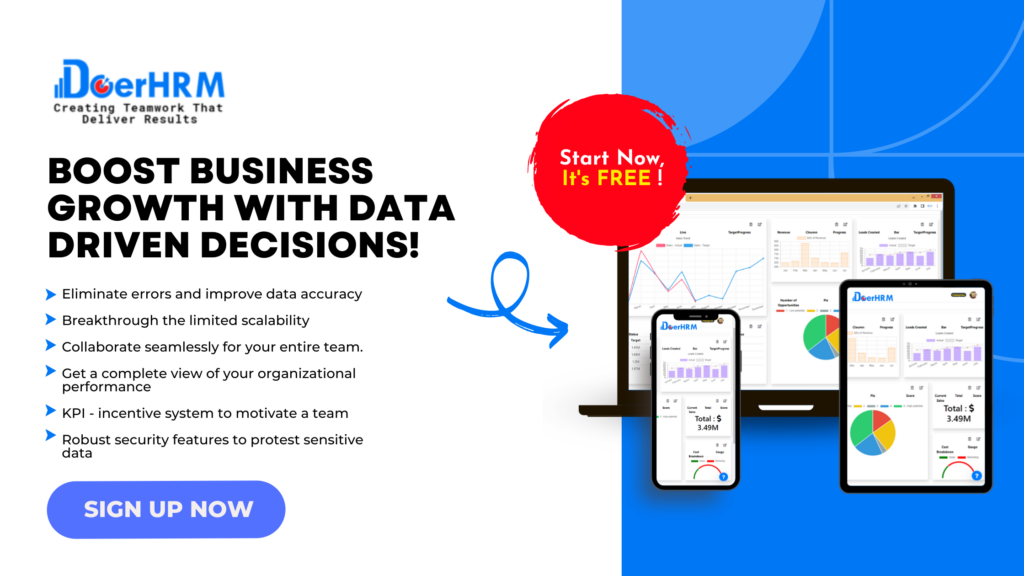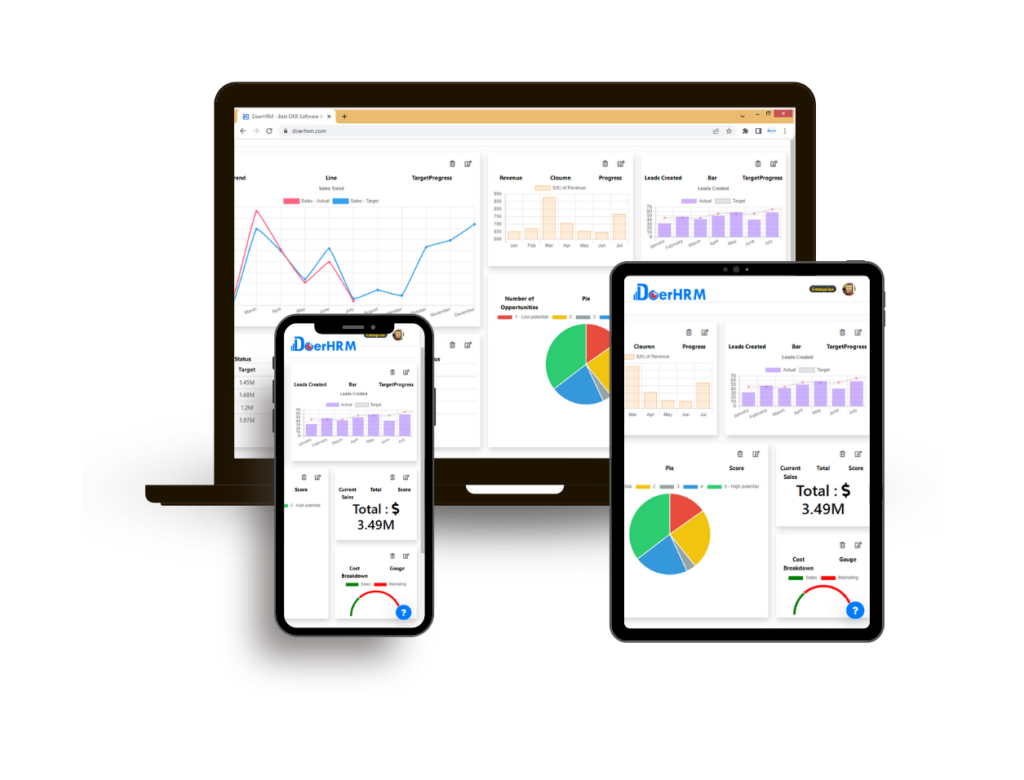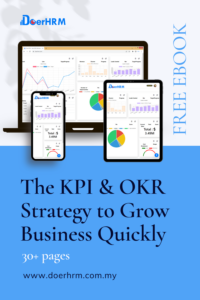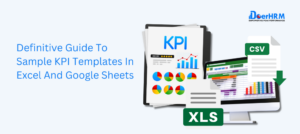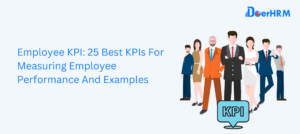Introduction
SMART KPI – In today’s fast-paced and competitive business world, organizations need to have a clear understanding of their goals and the progress they are making towards achieving them. This is where Key Performance Indicators (KPIs) come in – they are an essential tool for measuring and tracking progress towards business objectives.
However, not all KPIs are created equal. The most effective KPIs are those that are SMART – Specific, Measurable, Achievable, Relevant, and Time-bound. In this article, we will explore the importance of SMART KPI in business, how to use them effectively, and provide examples of SMART KPI that businesses can implement.
Related article : Why KPIs Are Important: 10 Reason Key Performance Indicators Stands For? -Meaning, Examples ,Template
Table of Contents
Explanation of KPIs
Key Performance Indicators (KPIs) are a set of measurable values that companies use to evaluate their success in achieving business objectives. KPIs are typically used to measure performance over time, track progress towards specific goals, and identify areas for improvement.
KPIs can be used to measure a variety of different business areas, including financial performance, customer satisfaction, employee productivity, and operational efficiency. For example, financial KPIs might include metrics such as revenue, profit margin, and return on investment. Customer satisfaction KPIs could include metrics such as Net Promoter Score (NPS) or Customer Effort Score (CES). Employee productivity KPIs might include metrics such as turnover rate, absenteeism, or employee engagement.
KPIs are important because they provide a way for companies to track their performance, make data-driven decisions, and continually improve. By measuring and analyzing key metrics, companies can identify areas where they are falling short and take action to improve. KPIs can also help companies set realistic goals and targets, and track their progress towards achieving them.
Related article: What Is A Key Performance Indicator (KPI)? Meaning, Templates, Examples
Definition of SMART KPI
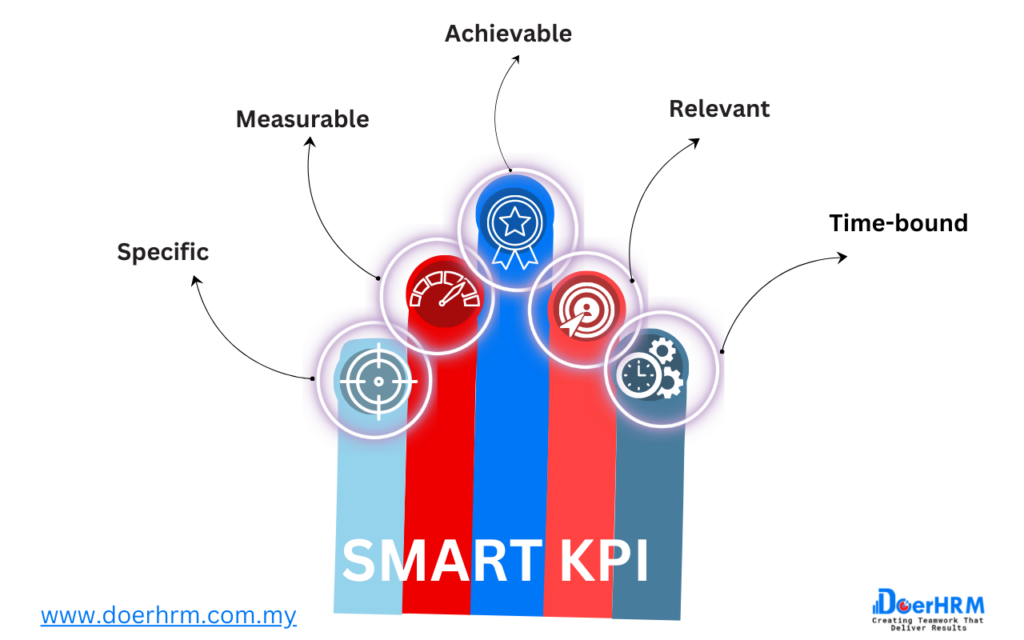
SMART KPI are a type of Key Performance Indicator that is designed to be specific, measurable, achievable, relevant, and time-bound. The term SMART is an acronym that stands for:
Specific: The KPI should be clearly defined and focused on a specific objective or goal. It should provide a clear picture of what is being measured, how it will be measured, and why it is important.
Measurable: The KPI should be quantifiable and measurable, using clear and concise metrics. It should provide an accurate representation of the current state of performance, and allow for comparison over time.
Achievable: The KPI should be realistic and achievable, based on the resources available and the current state of performance. It should provide a challenging but achievable goal that motivates the team to work towards it.
Relevant: The KPI should be directly related to the business objectives and goals. It should provide insight into the areas of the business that are most important and have the biggest impact on overall performance.
Time-bound: The KPI should have a specific timeline or deadline associated with it. It should provide a clear target for achievement, and allow for ongoing monitoring and adjustment over time.
By following these criteria, SMART Key Performance Indicators provide a framework for companies to set realistic goals, track progress, and achieve success. They help companies stay focused on what really matters, communicate clearly, and make informed decisions. SMART Key Performance Indicators are an important tool for any business that wants to improve its performance over time and achieve greater success.
Related article : Marketing KPI: 25 Digital Marketing Key Performance Indicators for Sales & Marketing- Manager, Department, Examples
Importance of SMART KPI in business
SMART KPI are crucial in helping businesses to achieve their objectives and improve their overall performance. The following are some of the benefits of using SMART Metricss in business:
Focus on specific objectives: Provide a clear focus on specific objectives, which helps to align business activities towards the achievement of the desired outcomes. This focus helps businesses to prioritize their efforts and allocate resources effectively.
Accurate and measurable performance: SMART KPI are quantifiable and measurable, which provides an accurate representation of performance. This allows businesses to monitor their progress and identify areas for improvement.
Increased motivation and engagement: SMART KPI are achievable and challenging, which motivates employees to work towards achieving them. This increased motivation and engagement can lead to higher productivity, better performance, and increased job satisfaction.
Better decision making: Provide data-driven insights that help businesses make informed decisions. This allows businesses to identify trends, patterns, and areas for improvement, and make adjustments accordingly.
Improved communication: Provide a common language and understanding of performance, which improves communication between teams and departments. This helps to ensure that everyone is aligned towards the same objectives and working towards the same goals.
Related article : Top 11 Important Training KPIs HR Managers Should Have
What is SMART KPI?
Explanation of SMART KPI
SMART K[PI are a set of criteria that are used to guide the creation of Key Performance Indicators (KPIs) for businesses. They are designed to ensure that KPIs are effective in measuring progress towards specific goals and objectives. SMART is an acronym for Specific, Measurable, Achievable, Relevant, and Time-bound. Here’s a more detailed explanation of each component:
Specific: A specific KPI should be clear and well-defined. It should answer the questions of what is being measured, why it’s being measured, and how it will be measured. This helps to ensure that everyone understands the purpose and focus of the KPI.
Measurable: A measurable KPI should be quantifiable and provide a clear indication of progress towards a specific goal. It should use clear and concise metrics that can be tracked over time. This helps to ensure that progress can be accurately measured and monitored.
Achievable: An achievable KPI should be challenging but also attainable based on the resources available. It should motivate employees to work towards achieving it without being so daunting that it leads to discouragement or burnout.
Relevant: A relevant KPI should be directly related to the business objectives and goals. It should provide insight into areas that are most important for achieving success and have the biggest impact on overall performance.
Time-bound: A time-bound KPI should have a specific timeline or deadline associated with it. This helps to create a sense of urgency and accountability and allows for ongoing monitoring and adjustment over time.
By incorporating each of these components, SMART Key Performance Indicators provide businesses with a clear framework for setting goals, measuring progress, and achieving success. They help to ensure that everyone is aligned towards the same objectives, that progress can be accurately measured and tracked, and that data-driven decisions can be made to improve performance. SMART Key Performance Indicators are an essential tool for any business that wants to improve its performance and achieve greater success.
Related article : Top 20 HR KPI Metrics & Examples for Human Resource Manager, Executive, Department – HRMS
The meaning behind the acronym SMART KPI
The acronym SMART KPI stands for Specific, Measurable, Achievable, Relevant, and Time-bound, which are the five criteria that a KPI must meet to be considered a SMART Key Performance Indicators. Here’s a more detailed explanation of each component:
Specific: A specific KPI is one that is focused on a particular business objective or goal. It should be well-defined and clear, so that everyone understands what is being measured, why it’s important, and how it will be measured. By having a specific KPI, businesses can ensure that their efforts are directed towards achieving the desired outcome.
Measurable: A measurable KPI is one that is quantifiable and provides a clear indication of whether progress is being made towards the goal. It should use clear and concise metrics that can be tracked over time to identify trends and patterns. By having a measurable KPI, businesses can track their progress and adjust their strategies accordingly.
Achievable: An achievable KPI is one that is challenging, but also realistic and attainable based on the resources available. It should motivate employees to work towards achieving it, without being so daunting that it leads to discouragement or burnout. By having an achievable KPI, businesses can ensure that their goals are realistic and achievable, which can increase employee engagement and motivation.
Relevant: A relevant KPI is one that is directly related to the business objectives and goals. It should provide insight into areas that are most important for achieving success and have the biggest impact on overall performance. By having a relevant KPI, businesses can focus on the areas that are most important for their success.
Time-bound: A time-bound KPI is one that has a specific timeline or deadline associated with it. This helps to create a sense of urgency and accountability and allows for ongoing monitoring and adjustment over time. By having a time-bound KPI, businesses can track their progress and adjust their strategies in a timely manner to achieve their goals.
Related article : Sales KPI: 28 Metrics for Sales Manager – Examples, Meaning, Template, Dashboard
Examples of SMART KPI
Revenue growth rate
Revenue growth rate is a SMART KPI that measures the percentage increase or decrease in a company’s revenue over a specific period. It helps businesses understand how well they are performing in terms of generating income and achieving their financial goals. To calculate revenue growth rate, the revenue from the current period is divided by the revenue from the previous period, subtracted by 1, and then multiplied by 100 to get the percentage increase or decrease.
For example, if a company had a revenue of $100,000 in Q1 and $150,000 in Q2, the revenue growth rate for Q2 would be ((150,000 – 100,000) / 100,000) x 100 = 50%. This means that the company’s revenue has increased by 50% from Q1 to Q2.
Setting a SMART SMART Key Performance Indicators goal for revenue growth rate could involve determining a specific percentage increase in revenue that the company wants to achieve over a certain period, such as a quarter or a year. For instance, a company may set a goal to achieve a 20% increase in revenue in the next quarter. By setting a specific target, the company can track its progress and make necessary adjustments to its strategy to achieve the desired growth rate.
Related article : Sales KPI: 28 Metrics for Sales Manager – Examples, Meaning, Template, Dashboard
Customer acquisition cost
Customer acquisition cost (CAC) is a key metric for businesses that are focused on growth. It measures the amount of money a business spends to acquire a new customer. CAC is calculated by dividing the total cost of sales and marketing efforts by the number of new customers acquired during a specific time period.
For example, if a business spends $100,000 on sales and marketing in a quarter and acquires 1,000 new customers during that time, the CAC would be $100 per customer.
Tracking CAC is important because it helps businesses understand the effectiveness of their sales and marketing efforts. By monitoring CAC over time, businesses can identify which channels are most effective for acquiring new customers and adjust their strategies accordingly.
Setting a SMART goal for CAC might involve aiming to reduce the cost per acquisition by a certain percentage over a specific time period. For example, a business might aim to reduce CAC by 10% over the next quarter by focusing on more targeted advertising or improving their sales process.
Employee turnover rate
Employee turnover rate is a metric used to measure the percentage of employees who leave a company within a specific period. This KPI can provide insights into the effectiveness of employee retention strategies and the overall health of the organization.
For example, to calculate the employee turnover rate, divide the number of employees who have left the organization by the total number of employees in the organization, and then multiply by 100 to get the percentage. The turnover rate can be calculated on a monthly, quarterly, or annual basis.
A high employee turnover rate can indicate that there are issues with employee satisfaction, training, compensation, or management. Conversely, a low employee turnover rate can indicate a healthy workplace culture and effective management practices.
Setting a specific target for the employee turnover rate can help organizations track their progress towards reducing turnover and retaining valuable employees. SMART targets for employee turnover rate may include reducing turnover by a certain percentage within a specific timeframe, or maintaining a turnover rate below a certain threshold.
Website traffic conversion rate
Website traffic conversion rate is a crucial SMART KPI for businesses that rely on their website for generating leads or sales. It measures the percentage of website visitors who take a specific action, such as filling out a form or making a purchase, out of the total number of visitors.
Setting a specific and measurable target for website conversion rate can help businesses improve the effectiveness of their website and digital marketing efforts. For example, if a business has a website conversion rate of 2%, they can set a target of 4% and work towards improving the website design, content, and user experience to achieve that target.
Monitoring website traffic conversion rate can also help businesses identify potential issues with their website or marketing campaigns, such as a high bounce rate or low click-through rate, and take corrective action to improve performance. Overall, tracking website traffic conversion rate as a SMART Key Performance Indicators can help businesses optimize their online presence and improve their bottom line.
Related article : Practical KPI Examples
Steps to follow when setting SMART KPI
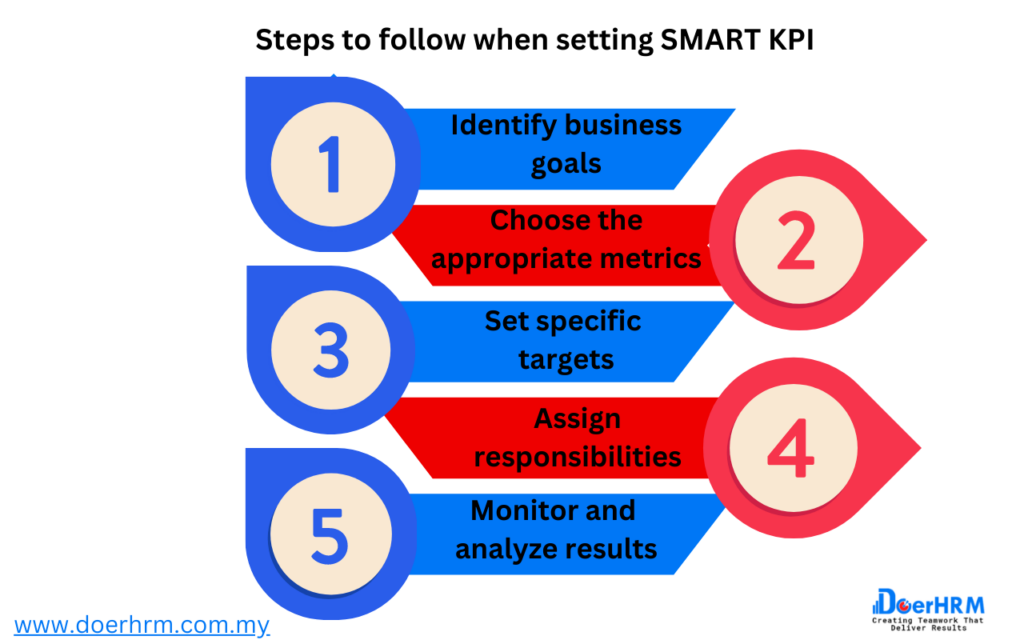
Identify business goals
The first step in setting SMART Key Performance Indicators is to identify your business goals. This involves determining what you want to achieve and why it’s important to your business. Your goals should be aligned with your overall business strategy, and should be specific, measurable, achievable, relevant, and time-bound.
To identify your business goals, start by conducting a SWOT analysis to identify your strengths, weaknesses, opportunities, and threats. This will help you to identify areas of your business that require improvement and areas where you can capitalize on opportunities.
Once you have identified your SWOT, you can then begin to set your business goals. Your goals should be specific and measurable, meaning that they should be clearly defined and able to be quantified. For example, instead of setting a goal to “increase sales,” you should set a goal to “increase sales by 10% in the next quarter.”
Your goals should also be achievable and realistic. While it’s important to set ambitious goals, you don’t want to set goals that are impossible to achieve. Make sure that your goals are attainable based on your current resources, capabilities, and market conditions.
Your goals should also be relevant to your business and aligned with your overall business strategy. Make sure that your goals are focused on areas that will help you to achieve your long-term vision and mission.
Finally, your goals should be time-bound, meaning that you should set a specific timeframe for achieving them. This helps to create a sense of urgency and ensures that you stay on track towards achieving your goals.
Related article : KPI Scorecards : Track Your Business Performance – Meaning , Template ,Dashboards , Examples
Choose the appropriate metrics
After identifying your business goals, the next step in setting SMART Metricss is to choose the appropriate metrics to measure your progress towards achieving those goals. Metrics are the specific data points that you will use to track your progress towards your goals.
When choosing metrics, it’s important to choose ones that are relevant to your goals and provide meaningful insights into your business performance. For example, if your goal is to increase sales, you might choose metrics such as revenue growth rate, customer acquisition cost, and conversion rate.
It’s also important to choose metrics that are specific and measurable, so that you can track your progress towards your goals. For example, if your goal is to increase website traffic, you might choose metrics such as total website visitors, page views per visitor, and bounce rate.
When choosing metrics, consider using a mix of leading and lagging indicators. Leading indicators are metrics that can predict future performance, while lagging indicators are metrics that measure past performance. By using a combination of leading and lagging indicators, you can get a more complete picture of your business performance and make more informed decisions.
Once you have chosen your metrics, make sure that you have a system in place to track and analyze them. This might involve setting up a dashboard or using a software tool to track your progress towards your goals. Make sure that you have a clear understanding of how you will collect and analyze the data, and that you have the necessary resources and expertise to do so effectively.
Related article : Social Media KPIs for Managers : 25 Metrics You Should Be Tracking for Your Marketing Strategy
Set specific targets
After you have identified your business goals and chosen the appropriate metrics to measure progress towards those goals, the next step in setting SMART Key Performance Indicators is to set specific targets. Setting specific targets helps to ensure that everyone on your team is working towards the same goal and gives you a clear benchmark for success.
When setting targets, it’s important to make sure that they are achievable and realistic, based on your current resources, capabilities, and market conditions. At the same time, your targets should also be ambitious and challenging, pushing you to reach for more.
Your targets should be based on your chosen metrics and should be specific and measurable. For example, if your goal is to increase website traffic, you might set a target to increase total website visitors by 20% in the next quarter.
When setting targets, it’s also important to consider the time frame for achieving them. Your targets should be time-bound, meaning that you should set a specific deadline for achieving them. This helps to create a sense of urgency and ensures that you stay on track towards achieving your goals.
Make sure that you communicate your targets clearly to everyone on your team, and that everyone understands their role in helping to achieve them. Set up a system for tracking progress towards your targets and make sure that everyone has access to the data they need to understand how their work is contributing to the overall success of the business.
By setting specific targets, you can focus your efforts and make sure that everyone is working towards the same goal. This helps to create a sense of alignment and ensures that everyone is working together towards the same outcome.
Assign responsibilities
After setting specific targets for your SMART Metrics, the next step is to assign responsibilities to team members. Assigning responsibilities ensures that everyone knows what they are accountable for and helps to ensure that progress towards your goals is being made.
To assign responsibilities effectively, start by identifying which team members are best suited to take on specific tasks or projects related to achieving your KPIs. Consider each team member’s skills, expertise, and workload when making these decisions.
Once you have identified the team members who will be responsible for specific tasks or projects, make sure that they have a clear understanding of their responsibilities and what is expected of them. Provide them with clear instructions and any necessary resources or support to help them achieve their goals.
It’s also important to set deadlines and timelines for completing each task or project. Make sure that each team member knows when their work is due and what the consequences will be for not meeting their deadlines.
Regular check-ins and progress updates can also help to ensure that everyone is on track towards achieving their goals. Use regular meetings or progress reports to review progress towards your SMART Key Performance Indicators and identify any challenges or areas where additional support may be needed.
By assigning responsibilities, you can ensure that everyone on your team knows what they are accountable for and is working towards achieving the same goals. This helps to create a sense of ownership and accountability and ensures that progress towards your SMART Key Performance Indicators is being made consistently over time.
Monitor and analyze results
Once you have set your SMART Metrics and assigned responsibilities, it’s important to regularly monitor and analyze your results to ensure that you are on track towards achieving your goals.
Monitoring involves tracking your progress towards your KPIs over time. This can be done by collecting and analyzing data related to each KPI. For example, if your KPI is customer acquisition cost, you would need to track the costs associated with acquiring new customers over time.
Analyzing your results involves interpreting the data collected during the monitoring process to gain insights into your performance. This can help you to identify trends, patterns, and areas for improvement. For example, if you notice that your customer acquisition costs are increasing, you may need to re-evaluate your marketing strategy to identify ways to reduce costs.
To monitor and analyze your results effectively, it’s important to have a system in place for collecting and analyzing data. This may involve using tools like dashboards or analytics software to track your KPIs and visualize your data. It’s also important to have a process for reviewing your results regularly and identifying any areas where changes may be needed.
When reviewing your results, it’s important to keep in mind the specific targets that you set for each KPI. This will help you to identify whether you are on track towards achieving your goals and whether any adjustments need to be made.
Overall, monitoring and analyzing your results is a critical part of using SMART Key Performance Indicatorsin business. It allows you to stay on track towards achieving your goals and make data-driven decisions to improve your performance over time.
Benefits of using SMART KPI
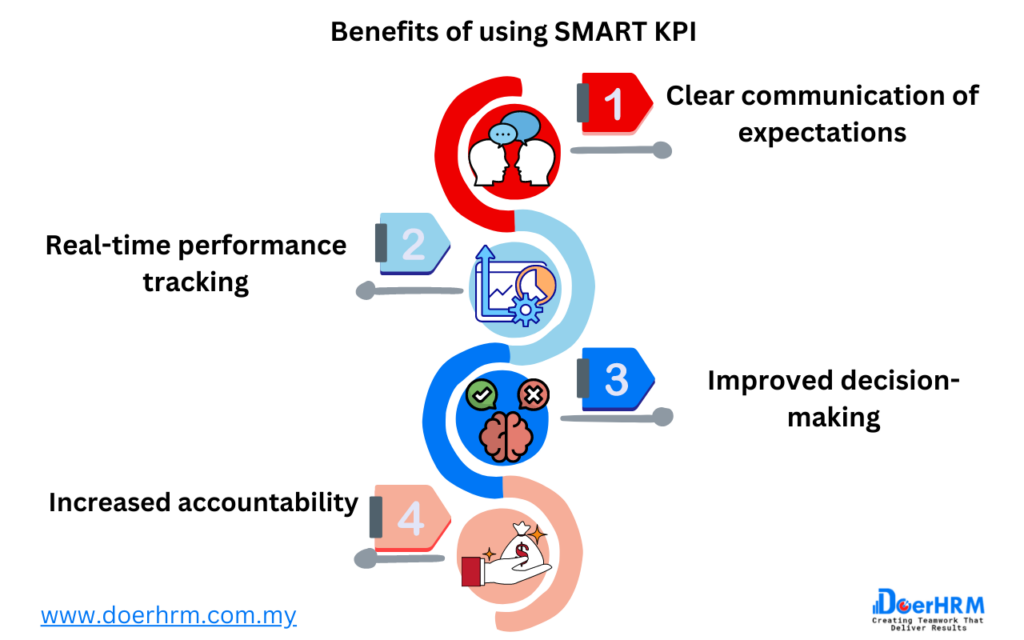
Clear communication of expectations
One of the main benefits of using SMART Key Performance Indicators in business is that they help to establish clear expectations for performance. By setting specific, measurable, achievable, relevant, and time-bound targets, SMART Key Performance Indicators provide a clear roadmap for what needs to be achieved and by when.
This clear communication of expectations is important for several reasons. First, it helps to ensure that everyone on the team is aligned with the company’s goals and understands what they need to do to contribute to those goals. This can help to improve collaboration and teamwork, as everyone is working towards a common objective.
Second, clear expectations help to reduce ambiguity and confusion around performance. When employees have a clear understanding of what they need to achieve, they are more likely to be motivated and engaged in their work. This can help to improve overall performance and productivity.
Third, clear expectations make it easier to evaluate performance and provide feedback. When KPIs are clearly defined and tracked, it’s easier to identify areas where improvements are needed and to provide specific feedback to employees on how they can improve. This can help to promote a culture of continuous improvement and development within the organization.
Overall, the clear communication of expectations that comes with using SMART Key Performance Indicators can help to improve performance, motivation, and collaboration within a business. By providing a clear roadmap for success, SMART Key Performance Indicators can help to ensure that everyone is aligned and working towards a common goal.
Related article : KPI In Project Management : KPIs In Agile For Planning Project Management – A Consultant’s Guide With Examples
Real-time performance tracking
Another benefit of using SMART Key Performance Indicators in business is the ability to track performance in real-time. By using digital dashboards and analytics tools, businesses can easily track progress towards KPI targets and identify areas where improvements are needed.
Real-time performance tracking provides several advantages. First, it allows businesses to identify issues early on and make adjustments quickly. For example, if website traffic is not converting at the expected rate, businesses can quickly identify the problem and make changes to the website or marketing strategy to improve conversion rates.
Second, real-time tracking helps to keep employees motivated and engaged. When employees can see their progress towards KPI targets in real-time, they are more likely to stay focused and motivated to achieve those targets. This can help to improve productivity and performance across the organization.
Third, real-time tracking allows businesses to make data-driven decisions. By having access to real-time data on KPI performance, businesses can make informed decisions on resource allocation, strategy, and other important business decisions. This can help to improve overall business performance and competitiveness.
Overall, real-time performance tracking is a powerful tool that comes with using SMART Key Performance Indicators By providing businesses with real-time data on performance, businesses can identify issues early, keep employees motivated, and make data-driven decisions that can help to improve overall business performance.
Improved decision-making
Another key benefit of using SMART Key Performance Indicators in business is that it can lead to improved decision-making. By using data to measure progress towards specific goals, businesses can make more informed decisions about resource allocation, strategy, and other important business decisions.
SMART Key Per formance Indicators provide businesses with the information they need to make informed decisions. By having access to real-time data on KPI performance, businesses can identify trends, patterns, and areas where improvement is needed. For example, if a business notices that its customer acquisition cost is higher than expected, it can analyze the data to identify the root cause of the issue and make adjustments to reduce costs.
In addition, SMART Key Performance Indicators help businesses to prioritize initiatives and allocate resources more effectively. By setting specific targets for each KPI, businesses can identify which initiatives are most important and allocate resources accordingly. This helps businesses to avoid wasting resources on initiatives that are not aligned with their strategic goals.
Overall, improved decision-making is a key benefit of using SMART Key Performance Indicators in business. By providing businesses with the data they need to make informed decisions, SMART Key Performance Indicators help to improve overall business performance and competitiveness.
Increased accountability
Another important benefit of using SMART Key Performance Indicators in business is increased accountability. When specific, measurable goals are set, and progress towards these goals is regularly tracked, individuals and teams are held accountable for their performance.
By assigning responsibilities for each KPI, employees are clear on what is expected of them and can take ownership of their work. They are aware of the specific goals they are working towards and can adjust their work to align with these goals.
The use of SMART Key Performance Indicators also promotes transparency and fosters a culture of continuous improvement. Employees are aware of how their performance is being measured and how their work contributes to the overall success of the business. This can lead to increased motivation, engagement, and job satisfaction.
In addition, the use of SMART Key Performance Indicators helps businesses to identify and address performance issues more quickly. By regularly monitoring KPI performance, businesses can identify areas where improvement is needed and take action to address these issues before they become more significant.
Overall, increased accountability is a key benefit of using SMART Key Performance Indicators in business. By promoting transparency, ownership, and a culture of continuous improvement, businesses can drive better performance and achieve their strategic goals.
Relate article: KPI for Finance Department: 26 Essential Metrics to Monitor for Finance Manager with Examples
Creating SMART KPI dashboard
Importance of a dashboard
A dashboard is a visual representation of data that provides an overview of key performance indicators (KPIs) for a business. A well-designed dashboard can be an effective tool for monitoring and analyzing business performance, and for identifying trends, opportunities, and challenges.
The importance of a dashboard lies in its ability to present complex data in a simple and easily understandable way. By displaying KPIs in a visually appealing format, businesses can quickly identify areas of concern and take action to address them.
Dashboards also provide a single source of truth for all stakeholders, ensuring that everyone has access to the same data and can make informed decisions based on the same information.
Additionally, a dashboard can be a valuable tool for communication and collaboration within an organization. By providing a clear and concise overview of business performance, dashboards can facilitate discussions between different teams and departments, helping to align efforts towards common goals.
Overall, a dashboard is an essential tool for businesses looking to monitor and improve performance. By providing an easy-to-understand snapshot of key metrics, dashboards can help businesses make data-driven decisions and stay focused on their strategic goals.
Related article : How To Create A Marketing KPI Dashboard
Components of dashboard
KPI selection: The first component of a SMART Key Performance Indicators dashboard is selecting the right KPIs to track. This involves identifying the most important metrics that align with business goals and are specific, measurable, attainable, relevant, and time-bound (SMART). It’s important to select KPIs that are relevant to the business and provide insight into key areas of performance. Once selected, the KPIs should be clearly defined and agreed upon by all stakeholders.
Data visualization: The second component of a SMART Key Performance Indicators dashboard is data visualization. The data should be presented in a way that is easy to understand and interpret, with visual representations such as charts, graphs, and tables. Data visualization can help to identify trends, patterns, and anomalies in the data and make it easier to communicate insights to stakeholders.
Periodic updates: The third component of a SMART Key Performance Indicators dashboard is periodic updates. KPIs should be updated regularly, depending on the frequency of data collection and the nature of the KPI. Updates should be provided at regular intervals, such as daily, weekly, or monthly, and should be communicated to all stakeholders in a timely manner. This allows businesses to monitor progress towards goals, identify issues, and take corrective action if necessary.
Overall, the components of a SMART Key Performance Indicators dashboard work together to provide a clear and concise overview of business performance. By selecting the right KPIs, visualizing the data in an easy-to-understand way, and providing regular updates, businesses can stay focused on their goals and make data-driven decisions to drive growth and success.
Why do you need to apply Smart KPIs in business?
DoerHRM – As businesses strive to remain competitive in their respective industries, the need for effective performance measurement becomes increasingly important. Key Performance Indicators (KPIs) are essential in determining how well a company is achieving its objectives and can help identify areas for improvement. However, not all KPIs are created equal, and that’s where SMART Key Performance Indicator come in.
SMART Key Performance Indicator are specific, measurable, achievable, relevant, and time-bound. They provide a clear and concise way to measure progress and identify areas of success and opportunities for improvement. Applying SMART Key Performance Indicators to business operations can be the key to achieving long-term success.
One platform that can help businesses implement SMART Key Performance Indicatorseffectively is DoerHRM. DoerHRM is an HR software that helps companies manage their employees’ performance, track their attendance, and monitor their productivity. With DoerHRM, businesses can easily set and monitor SMART Key Performance Indicators, making it easier to track progress and improve performance.
Using SMART Key Performance Indicator through DoerHRM can bring numerous benefits to businesses, such as better communication of expectations, real-time performance tracking, improved decision-making, and increased accountability. DoerHRM makes it easier to choose the right metrics, set specific targets, assign responsibilities, and monitor and analyze results.
In conclusion, implementing SMART Key Performance Indicator is crucial for businesses to remain competitive in their respective industries. DoerHRM provides a platform that can help businesses effectively implement SMART Key Performance Indicator, leading to better performance management, increased productivity, and long-term success.
Conclusion -SMART Key Performance Indicators
In conclusion, SMART Key Performance Indicator are a vital component of any successful business strategy. By setting specific, measurable, attainable, relevant, and time-bound targets, businesses can ensure that their efforts are aligned with their overall goals. The importance of SMART Key Performance Indicator lies in their ability to provide clear communication of expectations, real-time performance tracking, improved decision-making, and increased accountability.
To implement SMART Key Performance Indicator in your business strategy, it is crucial to follow a set of steps that include identifying your business goals, choosing the appropriate metrics, setting specific targets, assigning responsibilities, and monitoring and analyzing results. Additionally, creating a SMART Key Performance Indicators dashboard with the right components such as KPI selection, data visualization, and periodic updates can provide a comprehensive view of your business performance.
In conclusion, if you want to improve your business’s overall performance and achieve success, it is essential to implement SMART Key Performance Indicators in your strategy. By doing so, you can measure progress, make informed decisions, and ultimately achieve your business goals. So, start using SMART Key Performance Indicator today and take your business to the next level!
